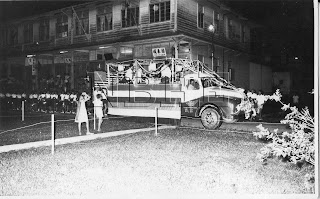The first things I noticed were the raintrees standing at the edge of the padang
 |
| Huge raintrees at the edge of the padang |
After a glass of cold lemon tea and some toast, it was time to explore Tenom. Someone said we should go to the coffee place where we’d be able to sample the famous Tenom coffee and buy some to take home. We walked from one block of shops to another but couldn’t locate the place. So Tenom isn’t such a small place if something as popular as a coffee outlet couldn’t be located.
“Is that it?” I asked Justin.
“No,” he said, “that’s the market.”
And further down: “No that’s a food court.”
“Closed? No customers?”
 |
| Closed shops |
 |
| Another closed shop |
 |
| More closed shops; note the sky! |
It was a Saturday but many shops were closed; their shutters pulled shut but unlocked. It was as if the proprietors have given their staff a break so they could go home for lunch and maybe take a nap before coming back to the shops.
We couldn’t locate the factory which produced the famous Tenom coffee so we walked along the quiet streets and five-footways to watch the people.
There were many used clothes vendors but hardly any potential customers rummaging through their goods. One could get bags and shoes, too!
There was a roomful of men enjoying themselves around the billiard tables… macam di KK. I was tempted to take a photo but those men would know I didn’t belong to Tenom so…
I passed through Tenom decades ago and I remember it as a vibrant, bustling place. It had been an important town during the NBCC era. With the building of the railway lines at the turn of the century, huge areas that were once inaccessible, virgin jungles had been opened up to turn them into rubber and coffee plantations. Because both these cash crops became huge revenue-earners, they later justified the building of the railway tracks through the uninhabited forests and along difficult terrain.
Tenom was also a busy town then because all traffic from the coastal towns of Sabah had to pass through Tenom to go to Keningau and Tambunan. (Tambunan was connected by road to KK only in the early 1970s.)
Since there was nothing much to see we strolled back to the railway station, stopping to see whatever caught our attention on the way.
People crossing the street despite the No-Crossing-Here sign. Note the closed shop.
Notice of road accidents. If there has been none since 1999, why bother updating the information? Good point!
Soon it was time to go. The train went pooot…pooooot! And Paul asked, “Is everyone on board?” No one appeared missing when the train pulled out of the station approximately two minutes before departure time.
But wait! When we were chugging along at ten miles an hour, and the Tenom Station was a faint dot in the distance, Caroline called! She had been left behind! Thank goodness for modern technology. Stop the train! Stop the train!
We discovered that not only the train could stop, it could reverse all the way back to the station!
Hello, Caroline and Annette. So sorry we didn’t notice you were missing!
There was no more exciting incident after that except at the stretch where a party of goats were strolling along the tracks dead ahead of our oncoming rail-bus.
Get off the tracks! Get off the tracks! But the goats, perhaps unaccustomed to the night train service, ran straight ahead. One poor, little goat must have been so tired it stopped on its track, turned around and looked up at us! Some passengers were already visualizing barbequed mutton—hot, moist and tender—beside their cold beers!
But the train slowed down and came to a complete stop. A few villagers standing near the tracks shooed the goats off the tracks into the dark night. We reached the station, happy that no goat was retrieved as a dead passenger.
 |
| The beautiful sunset was a fitting end to the great day! |
Let me conclude this post with a delightful poem written about the North Borneo train. It appeared in the fortnightly North Borneo Herald and is believed to have been written in 1912 or 1913 by an un-named writer.
Over the metals all rusted and brown
Thunders the mail to Jesselton town.
Tearing on madly, racking not fate,
Making up time—she’s three days late.
See how the sparks from her smoke-stack shower
Swaying on wildly at three miles an hour.
Sometimes they stop to examine a bridge,
Sometimes they stick on the crest of a ridge,
Sometimes they find the line washed away
And postpone their advance the following day.
Beaufort to Jesselton—tour of delight—
Taking all day and the best of the night.
Over the rails all rusted and brown
Drives on the mail to Jesselton town.
(Thank you to Susan for pointing out the poem to NBHE! And our heartfelt appreciation goes to our gracious host, Paul, and the GMR and his SSR crew for making the trip possible!)

































